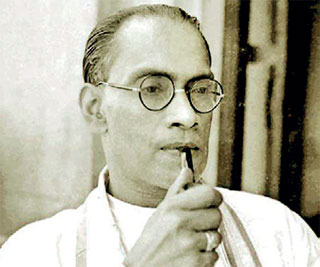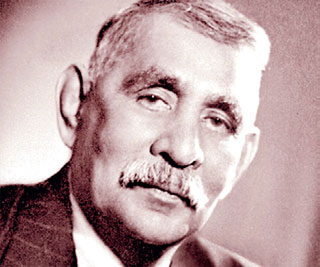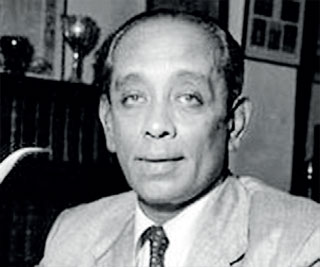Thursday Dec 12, 2024
Thursday Dec 12, 2024
Wednesday, 19 October 2022 00:30 - - {{hitsCtrl.values.hits}}

S.W.R.D. Bandaranaike

D.S. Senanayake

G.G. Ponnambalam
|
 The course of contemporary politics in Sri Lanka has created a situation where federalism or the federal idea is identified with the political aspirations of the Tamils of Sri Lanka. The ‘Ilangath Thamizhar’ or Lankan Tamils whose areas of historic habitation in the Island are the predominantly Tamil speaking Northern and Eastern Provinces have for many decades sought to establish a federal or quasi-federal system of governance in these provinces. This demand has been looked upon with suspicion by the Sinhala people. So much so that federalism has become the “F-word” in Lankan politics. Even devolution is being turned into a “dirty” word by some nowadays.Against this backdrop it is indeed ironic to note that federalism was first introduced to the political discourse of the country by Sinhala political leaders during British rule when Sri Lanka was known as Ceylon. It may also be interesting to note that when federalism as a form of governance was proposed in the pre-independence period by Sinhala leaders there were no takers for it among Tamils. Post-independence politics however saw a reversal of roles. The demand for federalism began gaining support among Tamils. This resulted in Sinhala leaders losing enthusiasm for the federal idea. Subsequent events saw federalism becoming discredited among Tamils too as secessionism and armed struggle gained dominance.Those desiring a federal solution feel that unity is possible amidst diversity but those opposing it opine that only “unitary” will bring about unity. What the unitary propagandists forget or ignore is that the island’s current avatar as a single state was made possible only by the British colonialists. It was in 1832 that the British unified the country into modern Ceylon by forging together the Kandyan, Low-Country, and maritime regions into one entity. The existing 32 administrative divisions were compressed into five provinces. Some decades later the five became nine provinces.
The course of contemporary politics in Sri Lanka has created a situation where federalism or the federal idea is identified with the political aspirations of the Tamils of Sri Lanka. The ‘Ilangath Thamizhar’ or Lankan Tamils whose areas of historic habitation in the Island are the predominantly Tamil speaking Northern and Eastern Provinces have for many decades sought to establish a federal or quasi-federal system of governance in these provinces. This demand has been looked upon with suspicion by the Sinhala people. So much so that federalism has become the “F-word” in Lankan politics. Even devolution is being turned into a “dirty” word by some nowadays.Against this backdrop it is indeed ironic to note that federalism was first introduced to the political discourse of the country by Sinhala political leaders during British rule when Sri Lanka was known as Ceylon. It may also be interesting to note that when federalism as a form of governance was proposed in the pre-independence period by Sinhala leaders there were no takers for it among Tamils. Post-independence politics however saw a reversal of roles. The demand for federalism began gaining support among Tamils. This resulted in Sinhala leaders losing enthusiasm for the federal idea. Subsequent events saw federalism becoming discredited among Tamils too as secessionism and armed struggle gained dominance.Those desiring a federal solution feel that unity is possible amidst diversity but those opposing it opine that only “unitary” will bring about unity. What the unitary propagandists forget or ignore is that the island’s current avatar as a single state was made possible only by the British colonialists. It was in 1832 that the British unified the country into modern Ceylon by forging together the Kandyan, Low-Country, and maritime regions into one entity. The existing 32 administrative divisions were compressed into five provinces. Some decades later the five became nine provinces.
Even as the unified Ceylonese nation began progressing towards self-government under British rule the necessity for some form of de-centralisation and/or devolution was felt. Both de- centralisation and devolution were used interchangeably in those days. The first person of eminence to propose federalism for Ceylon was none other than Solomon West Ridgeway Dias Bandaranaike (SWRDB).
S.W.R.D. Bandaranaike
S.W.R.D. Bandaranaike returned home in 1925 after pursuing a brilliant academic career at Christ Church College, Oxford. Like many young idealists from countries under colonial bondage, SWRDB too came back with a zealous sense of mission to serve his country and people. While being a member of the Ceylon National Congress, Bandaranaike also founded a political party known as the ‘Progressive National Party’ to achieve the goal of political self-government. S.W.R.D. Bandaranaike became the leader of the Progressive National Party while C. Ponnambalam of the Jaffna Youth Congress was the Secretary.
The Oxford returned SWRDB was of the view then that Ceylon should become a federation. The Progressive National Party in its Constitution detailed an outline of the federal system Bandaranaike had in mind. While noting that the three main groups in the country were the Low-Country Sinhalese, Up-Country Sinhalese and the Tamils, the party constitution wanted the federal system to be based on the nine provinces with each of the nine provinces having complete autonomy. There was to be a bicaramel legislature consisting of a “House of Commons” and “House of Senators”. Bandaranaike’s proposal for a Federal Constitution was supported by all members of the Progressive National Party except one. The solitary dissident was the scholar James T. Rutnam who was Bandaranaike’s close friend and associate.
S.W.R.D. Bandaranaike wrote a series of six articles for the “Ceylon Morning Leader” articulating his vision on Federalism. The preliminary article appeared on 19 May 1926. The following excerpts are from the introductory paragraphs in the preliminary article:
“At a time when the desire for self-government appears to be growing ever stronger, and successive instalments of ‘reforms’ seem to bring that goal almost within sight, two problems of vital importance arise, which require careful and earnest thought.”
“The first is the question of Ceylon’s external status, that is what is her position as a nation in relation to other nations.”
“The second is her internal status, the adoption of a form of government which would meet the just requirements of the different sections of her inhabitants… The writer believes the true solution to the problem mentioned is contained in the federal system and these articles are intended as a general introduction to the subject”.
Bandaranaike’s advocacy of federalism did not create a major political splash at that time. Only ripples. The federal idea did not evoke a communal or Sinhala backlash then.
Jaffna Students’ Congress
The federal idea when suggested by SWRDB in 1926 was opposed by the Jaffna Students’ Congress later renamed as the Jaffna Youth Congress. Bandaranaike was invited by the Jaffna congress to deliver a lecture to a large audience in Jaffna. SWRDB travelled up to Jaffna and spoke on federalism at a meeting held on 26 July 1926.
The well-attended meeting was presided over by Dr. Issac Thambyayah. Young Bandaranaike spoke eloquently on the topic “Federation as the only solution to our political problems”. SWRDB argued that regional autonomy was the ideal way to manage communal differences. The audience was neither impressed nor enamoured by the federalism pitch. Bandaranaike was subjected to a barrage of questions challenging federalism as a valid form of government for the island. SWRDB answered with great erudition but there were few takers for federalism among Tamils in Jaffna then.
Nevertheless S.W.R.D. Bandaranaike stood firm saying, “A thousand and one objections could be raised against the system, but when the objections are dissipated, I am convinced that some form of Federal Government will be the only solution.”
While the Tamils of Ceylon/Sri Lanka treated the federal idea as politically untouchable another ethnic sub-group touted federalism as a manthra in the twenties of the twentieth century. Kandyan Sinhala representatives who were mainly of the Radala elite were suspicious of a political system where the numerically larger Low-Country Sinhalese could swamp them. So they went before the Donoughmore Commission in 1927 and proposed a federal Ceylon comprising three units. One for the three Kandyan provinces, one for the four Low-Country provinces and one for the two Tamil provinces of the north and east.
|
Donoughmore Commission
What had happened then was that the political climate of Ceylon/Sri Lanka had undergone transformation with the advent of the Donoughmore Commission. A four-member team headed by Lord Donoughmore was appointed by Whitehall to hear representations and propose a new constitutional arrangement for Ceylon.
The Donoughmore Commission spent four months in the island from 18 August 1927 to 18 January 1928. The commissioners held 34 sittings and interviewed over 140 persons from various delegations. Several petitions and appeals in writing were also accepted.
The Donoughmore Commission released its report on 28 June 1928. As a result of the Donoughmore report universal suffrage for men and women over 21 years was made possible. Communal representation was abolished and territorial representation was introduced. A legislature known as the State Council was established with 50 elected and 8 appointed representatives in 1931. A board of seven ministries was also set up.
Kandyan National Assembly
When the Donoughmore Commission was in the country several political groups and organisations representing race, religion, caste and creed made representations. Among these was the Kandyan National Assembly (KNA) consisting of Up-Country Sinhala leaders who had broken away from the Ceylon National Congress in 1925. Their main problem at that time was the large scale migration of low-country Sinhalese into the highland provinces.
Leaders of the Kandyan National Assembly such as A. Godamune had earlier welcomed the federalism proposal of S.W.R.D. Bandaranaike. Now the Kandyan National Assembly appealed to the Donoughmore Commission for a scheme of three federal units. The first was for the Kandyan Sinhalese of Uva, Sabaragamuwa and Central Provinces. The second was for the Low-Country Sinhalese of Southern, Western, North Western and North Central Provinces. The third was for the Sri Lankan Tamils of the Northern and Eastern Provinces.
According to the KNA, the Kandyan Sinhalese were a distinct nation. In making this claim before the Donoughmore Commission the Kandyan National Assembly delegation argued thus: “Ours is not a communal claim or a claim for the aggrandisement of a few; it is a claim of a nation to live its own life and realize its own destiny... We suggest the creation of a federal state as in the United States of America... A federal system will enable the respective nationals of the several federal states to prevent further inroads into their territories and to build up their own nationalities.”
Dr. Rohan Edrisingha in his illuminating essay “Federalism: myths and realities” makes the following observation: “It is significant to note that long before Tamil political leaders advocated federalism, the young S.W.R.D. Bandaranaike in the mid-1920s and the Kandyan Sinhalese representatives before the Donoughmore Commission in the late 1920s were advocates of a federal Sri Lanka. The Kandyan Sinhalese proposed a federal Ceylon with three provinces including a province for the North-East. In fact it is possible to argue that it was the Kandyan Sinhalese and not the Ceylon Tamils who were not only the champions of a federal Ceylon but also the merger of the north and east. The Kandyan Sinhalese in fact viewed themselves as a nation and many of the documents of the organisations they established to advance their cause used language and arguments similar to Tamil nationalists and Tamil political groups in the more recent past. They were concerned about the influx of Low-Country Sinhalese into the Kandyan region.”
It could be seen therefore that federalism was first proposed by Sinhala political leaders. S.W.R.D. Bandaranaike, the greatest intellectual among Sinhala political leaders of that era, espoused some form of federalism as the only solution as far back as 1926. Kandyan Sinhala leaders recommended a federal arrangement of two units for Sinhalese and one unit comprising the north-east for Tamils in 1927.
Tamil political leaders
If Sri Lankan Tamil political leaders had availed themselves of the opportunity and demanded that the British grant federalism for the Tamils of the north and east there was every chance that the request might have been acceded to. The Kandyan Sinhala and Sri Lankan Tamil political leaders could have pressurised the Low-Country Sinhala leaders in a political pincer. Yet this did not happen. The Sri Lankan Tamil political leaders did not demand federalism or even a separate state while the British were ruling. Instead these demands were raised only after the British left our shores.
The Tamils of Sri Lanka lacked an effective leader when the Donoughmore Commission arrived in 1927. Sir Ponnambalam Arunachalam had passed away in 1924. His elder brother Sir Ponnambalam Ramanathan revived the Tamil League formed by Arunachalam and made representations before the Donoughmore Commission. Other Tamil organisations also followed suit. The Tamil representation spearheaded by Sir Ponnambalam Ramanathan neither sought secession nor federalism. Instead it asked for greater political representation for the Tamils. Ramanathan opposed territorial representation and supported the communal representation principle.
The Tamils did not think of a federal arrangement for the north-east but argued for communal representation based on greater weight for the Tamils. The Sri Lankan Tamils were aiming at seats in the envisaged legislature on a ratio of two to one. They wanted one third of seats to be allocated for the Tamils and two-thirds for the Sinhalese. The Donoughmore Commission rejected communal representation as a “cancer eating into the body politic” and ushered in territorial representation. This provided the Sinhala people a greater advantage in obtaining more representation. A disappointed Ramanathan who was to die in 1930 lamented loudly, “Donoughmore mea-ns Tamils no more”. Ramanathan’s emerging political successor G.G. Ponnambalam described the Donoughmore Cons-titution as a “political windfall” for the Sinhalese.
|
Soulbury Commission
Another commission to recommend constitutional reform proposals for Ceylon was appointed by Great Britain in 1944. This was headed by Viscount Soulbury and became known as the Soulbury Commission. The premier political organisation of the Sri Lankan Tamils at that time was the All Ceylon Tamil Congress. G.G. Ponnambalam was the leader of the Tamil Congress then. The secretary was lawyer S. Sivasubramaniam whose son S. Kathiravetpillai was Kopay MP from 1965 to 1981. Among the prominent leaders in the Tamil Congress was S.J.V. Chelvanayagam who later split and formed in 1949 the Ilankai Thamil Arasu Katchi (ITAK) known as the Federal Party.
It is indeed noteworthy that the Tamil political leadership of the pre-Independence period did not campaign for separation or federalism before the Soulbury Commission. They wanted a scheme where the minority community representation was to be given weightage so that the non-Sinhala communities together could counter-balance perceived Sinhala domination. The Tamil Congress fought hard for a scheme of balanced representation popularly called “fifty-fifty”.
According to this proposal, 50% of seats were to be allocated for the Sinhala majority and 50% for all the other minority ethnicities including Tamils. This was rejected by the Soulbury Commission which refused to create an “artificial majority out of a minority” through a balanced representation scheme. Ceylon gained Dominion status in 1947 and full independence from the British in 1948. The British Governor Sir Henry Mason Monck Moore became Governor General and served till 1949. He was succeeded by Soulbury as Governor General. He served till 1954.
Missed golden opportunities
Post-independence developments coupled with the wisdom of hindsight suggest that the Sri Lankan Tamils may have missed golden opportunities by not demanding federalism during British rule. One reason for the Tamil leadership not opting for a federal north-east then was due to the fact that the Tamil political hierarchy of that time was essentially composed of the Colombo based elite.
With Tamils enjoying a larger proportion in prestigious professions, government jobs and commerce in Sinhala areas, the dominant Tamil elite did not want to be confined to the north and east through federalism. The Tamil leadership perceived the community as being “all-island” rather than “regional” hence the Tamil Congress was named All Ceylon Tamil Congress. Subsequent events proved how short-sighted this pre-independence belief was.
Meanwhile the Sinhala polity underwent a change. There was a closing of ranks between the Low-Country and Up-Country Sinhalese on the one hand and the Govigama-Karawe elites on another.
Greater Sinhala unity
The Kandyan Sinhala leaders who feared a Low-Country Sinhala influx were now besieged by another perceived danger. They feared being inundated by the plantation workers of Indian origin in their midst. Furthermore G.G. Ponnambalam’s futile efforts to mobilise the minority communities and gang up on the majority community resulted in the Sinhalese defensively forging greater unity among themselves.
Independent Ceylon’s first pri-me minister D.S. Senanayake was a Low-Country Sinhalese. His Government de-citizenised and disenfranchised the Tamils of Indian origin after Independence. This resulted in Kandyan Sinhala political representation increasing.
Gradually the Low-Country – Up-Country Sinhala differences began diminishing. Nowadays most Kandyan Sinhalese would be horrified to hear that their leaders at one time had imagined themselves to be a separate nation and had advocated a federal arrangement that included a merged unit for the north and east.
(This is a modified version of an earlier article.)
(The writer can be reached at [email protected].)